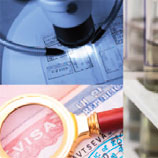7
UNODC releases guide to strengthen border examination of documents
17 January 2011 - When people are smuggled from one border to the next, chances are high that the travel documents they use have been falsified by smugglers. While many developed countries' immigration control and border security have developed hi-tech apparatus to detect and disseminate intelligence about such fraudulent documents, the same cannot be said of developing nations.
"Fraudulent identity and security documents are the grease that eases cross-border crime of all types: smuggling of migrants, trafficking in persons, terrorist mobility, smuggling of drugs, weapons and other goods, and fraud. Unfortunately there is a lack of awareness among relevant criminal justice practitioners of the benefits that forensic document examinations may provide to assist border control security and immigration facilities", explains Justice Tettey, the Chief of the Laboratory Section at UNODC.
In order to build this capacity, UNODC has issued a guide to provide practical assistance for the establishment or upgrading of forensic document examination and intelligence dissemination capacities in a holistic manner by encompassing identity, security and other types of documents without security features. The guide, entitled
Guide for the Development of Forensic Document Examination Capacity aims to provide assistance to two categories of service providers: immigration and border control agencies and forensic science laboratories.
Security documents refer to documents containing incorporated security features within the document to protect the value of the document. Many identity documents contain security features such as passports, identity cards, and driving licenses. Other examples of security documents include currency, social security cards, travel visas and lottery tickets, etc.
Identity documents are any documents which may be used to verify aspects of a person's personal identity. Some countries require individuals to carry a government issued identity card, while other countries may accept a driver's licence as an effective means of proof of identity.
"The current guide caters to several levels of country/agency development from the most basic to advanced capability. It focuses on building staff skills and educational requirements needed to perform forensic document examinations and to provide court testimony, intelligence alerts and training", adds Mr. Tettey.
The guide further gives recommendations on the type of forensic equipment to use, reference collections and databases as well as general guidance for designing, establishing and maintaining a forensic document examination facility. It complements an existing UNODC manual
Staff skill requirements and equipment recommendations for forensic science laboratories which covers all forensic disciplines and contains more detailed information on document examinations.
"The information contained within this guide will have the greatest impact if a careful assessment of existing resources and equipment is carried out prior to developing capacities; a step-by-step approach is applied to the purchase of new or upgraded equipment; and adequate resources are made available to maintain the acquired equipment and databases", says Mr. Tettey.
Related Information:
UNODC Laboratory and Forensic Sciences Services
Guide for the Development of Forensic Document Examination Capacity (pdf)
